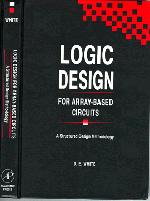Logic Design for Array-Based Circuits
by Donnamaie E. White
Copyright © 1996, 2001, 2002, 2008, 2016 Donnamaie E. White , WhitePubs Enterprises, Inc.
- Table of Contents
- Preface
- Overview
- Chapter 1 Introduction
- Chapter 2 Structured Design Methodology
- Chapter 3 Sizing the Design
- Chapter 3 Appendix = Case Study in Sizing a Design
- Chapter 4 Design Optimization
- Chapter 5 Timing Analysis for Arrays
- Chapter 6 External Set-up and Hold Times
- Chapter 7 Power Considerations
- Case Study: DC Power Computation
- Case Study: AC Power Computation
- Chapter 8 Simulation
- Case Study: Simulation
- Chapter 9 Faults and Fault Detection
- Chapter 10 Design Submission
- ASIC Glossary
|
The original form of this book was published by Academic Press, 1250 Sixth Avenue, San Diego, California 92101-4311 in 1992. ISBN 0-12-746660-6. The figures were reproduced with the permission of Applied Micro Circuit Corporation. The Q20000 Series and other bopolar and BiCMOS series referenced belong to AMCC. EPAC is a trademark of IMP, Inc. |
Preface

This book was based on classes taught at USCD and at AMCC's customer Design Center 1984 - 1994. It is based on schematic capture rather than Verilog or VHDL input and on manual support rather than the newer tools available for static timing verification, test generation, synthesis, etc. The Design Flow is, however, still the same. The steps must be done, with or without tools. This book details the theory behind the new EDA tools. Customer training courses prepared by high-technology vendors are a required extension to that training available in the engineering classes at the college level. The quality of that training can vary with the experience of the instructor. The experience of the instructor with the nuances of the products is one facet. The teaching expertise is another. The purpose behind this book was to document what a proven instructor was adding to the course material and manuals. By providing this supplement, it would be possible for other, less experienced instructors, to take over the actual presentation of the seminars while ensuring no loss of insight into the methodology or product taught. The course on which the book was based was rewritten for each new array series and technology change made by Applied Micro Circuits Corporation. The array series covered originally included the bipolar Q700 (1000 gates on a chip running at 200 MHz) and ends with the Q20000 (20000 gates on a chip running at 1.2 GHz), with CMOS and BiCMOS added along the way. Structured DesignIn the process of these rewrites, it became obvious that a certain core of the seminar remained inviolate - the structured, orderly, logical approach to circuit design . This approach was taken from discrete board design, from SSI-MSI logic design, from bit-slice design, from structured software and firmware programming, and from systems concepts. This core material is represented in this text. The emphasis is on the total design picture - all those myriad of details that interleave. What was also obvious is that examples that are wrong as well as those that are right are essential to rapid assimilation of the material. The last array series turned to for examples was the 1994-1995 AMCC Q20000 Bipolar array series. The goal has been to create a book that can be used with any vendor's array series. It applies those designing circuits for an ASIC, Application Specific Integrated Circuit, vendor to produce, and to those vendors who are designing ASSPs, Application Specific Special Products, standard products that are designed to be built on an array base wafer. (ASSPs are the latest addition to the designer's toolbox.) AcknowledgmentsThe author would like to thank the AMCC staff for their time and energy expended in the compilation of this material, with specific thanks to Richard W. Spehn for his expertise and encouragement.
|
Copyright © 1996, 2001, 2002, 2008, 2016 Donnamaie E. White , WhitePubs
Enterprises, Inc.
For problems or questions on these pages, contact [email protected]